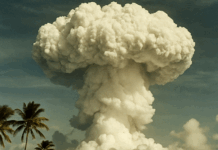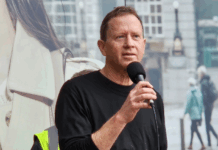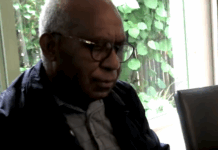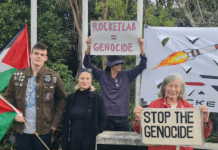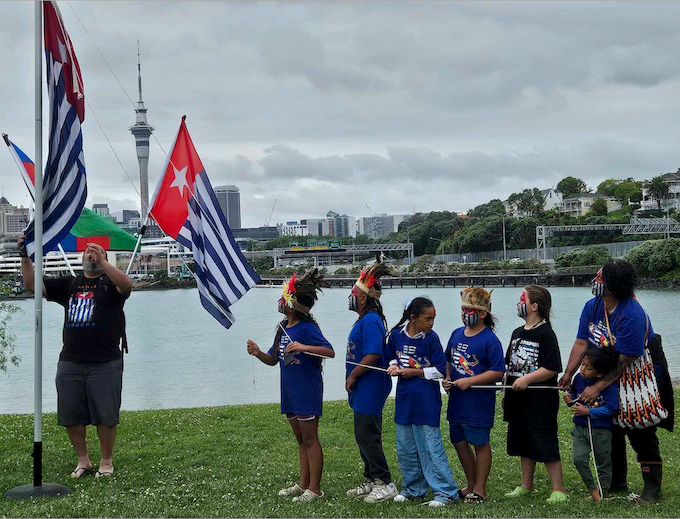
On Papuan Independence Day, the focus is on discussing protests against Indonesia’s transmigration programme, environmental destruction, militarisation, and the struggle for self-determination. Te Ao Māori News reports.
By Te Aniwaniwa Paterson
On 1 December 1961, West Papua’s national flag, known as the Morning Star, was raised for the first time as a declaration of West Papua’s independence from the Netherlands.
Sixty-three years later, West Papua is claimed by and occupied by Indonesia, which has banned the flag, which still carries aspirations for self-determination and liberation.
The flag continues to be raised globally on December 1 each year on what is still called “Papuan Independence Day”.
Region-wide protests
Protests have been building in West Papua since the new Indonesian President Prabowo Subianto announced the revival of the Transmigration Programme to West Papua.
This was declared a day after he came to power on October 21 and confirmed fears from West Papuans about Prabowo’s rise to power.
This is because Prabowo is a former general known for a trail of allegations of war crimes and human rights abuses in West Papua and East Timor to his name.
Transmigration’s role
The transmigration programme began before Indonesia gained independence from the Dutch colonial government, intended to reduce “overcrowding” in Java and to provide a workforce for plantations in Sumatra.
After independence ended and under Indonesian rule, the programme expanded and in 1969 transmigration to West Papua was started.
This was also the year of the controversial “Act of Free Choice” where a small group of Papuans were coerced by Indonesia into a unanimous vote against their independence.
In 2001 the state-backed transmigration programme ended but, by then, over three-quarters of a million Indonesians had been relocated to West Papua. Although the official transmigration stopped, migration of Indonesians continued via agriculture and development projects.
Indonesia has also said transmigration helps with cultural exchange to unite the West Papuans so they are one nation — “Indonesian”.
West Papuan human rights activist Rosa Moiwend said in the 1980s that Indonesians used the language of “humanising West Papuans” through erasing their indigenous identity.
“It’s a racist kind of thing because they think West Papuans were not fully human,” Moiwend said.
Pathway to environmental destruction
Papuans believe this was to dilute the Indigenous Melanesian population, and to secure the control of their natural resources, to conduct mining, oil and gas extraction and deforestation.
This is because in the past the transmigration programme was tied to agricultural settlements where, following the deforestation of conservation forests, Indonesian migrants worked on agricultural projects such as rice fields and palm oil plantations.
Octo Mote is the vice-president of the United Liberation Movement for West Papua (ULMWP). Earlier this year Te Ao Māori News interviewed Mote on the “ecocide and genocide” and the history of how Indonesia gained power over West Papua.
The ecology in West Papua was being damaged by mining, deforestation, and oil and gas extraction, he said. Mote said Indonesia wanted to “wipe them from the land and control their natural resources”.
He emphasised that defending West Papua meant defending the world, because New Guinea had the third-largest rainforest after the Amazon and Congo and was crucial for climate change mitigation as they sequester and store carbon.
Concerns grow over militarisation
Moiwend said the other concern right now was the National Strategic Project which developed projects to focus on Indonesian self-sufficiency in food and energy.
Merauke Integrated Food and Energy Estate (MIFEE) started in 2011, so isn’t a new project, but it has failed to deliver many times and was described by Global Atlas of Environmental Justice as a “textbook land grab”.
The mega-project includes the deforestation of a million hectares for rice fields and an additional 600,000 hectares for sugar cane plantations that will be used to make bioethanol.
The project is managed by the Ministry of Defense and the Ministry of Agriculture, and the private company, Jhonlin Group, owned by Haji Andi Syamsuddin Arsyad. Ironically, given the project has been promoted to address climate issues, Arsyad is a coal magnate, a primary industry responsible for man-made climate change.
Recently, the Indonesian government announced the deployment of five military battalions to the project site.
Conservation news website Mongabay reported that the villages in the project site had a population of 3000 people whereas a battalion consisted of usually 1000 soldiers, which meant there would be more soldiers than locals and the villagers said it felt as if their home would be turned into a “war zone”.
Merauke is where Moiwend’s village is and many of her cousins and family are protesting and, although there haven’t been any incidents yet, with increased militarisation she feared for the lives of her family as the Indonesian military had killed civilians in the past.
Destruction of spiritual ancestors
The destruction of the environment was also the killing of their dema (spiritual ancestors), she said.
The dema represented and protected different components of nature, with a dema for fish, the sago palm, and the coconut tree.
Traditionally when planting taro, kumara or yam, they chanted and sang for the dema of those plants to ensure an abundant harvest.
Moiwend said they connected to their identity through calling on the name of the dema that was their totem.
She said her totem was the coconut and when she needed healing she would find a coconut tree, drink coconut water, and call to the dema for help.
There were places where the dema lived that humans were not meant to enter but many sacred forests had been deforested.
She said the Indonesians had destroyed their food sources, their connection to their spirituality as well destroying their humanity.
“Anim Ha means the great human being,” she said, “to become a great human being you have to have a certain quality of life, and one quality of life is the connection to your dema, your spiritual realm.”
Te Aniwaniwa Paterson is a digital producer for Te Ao Māori News. Republished with permission.



